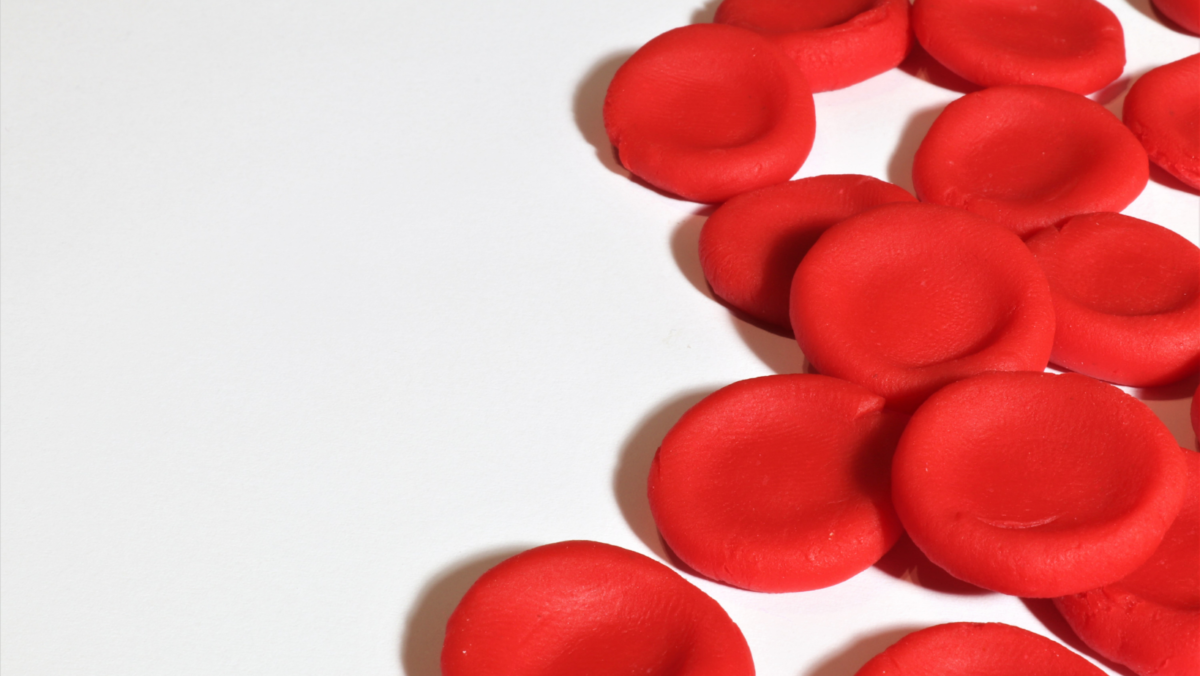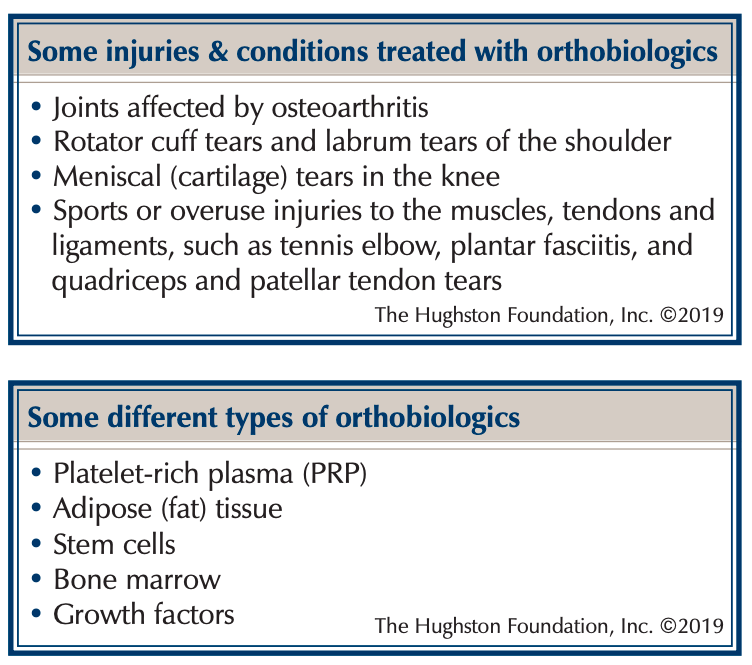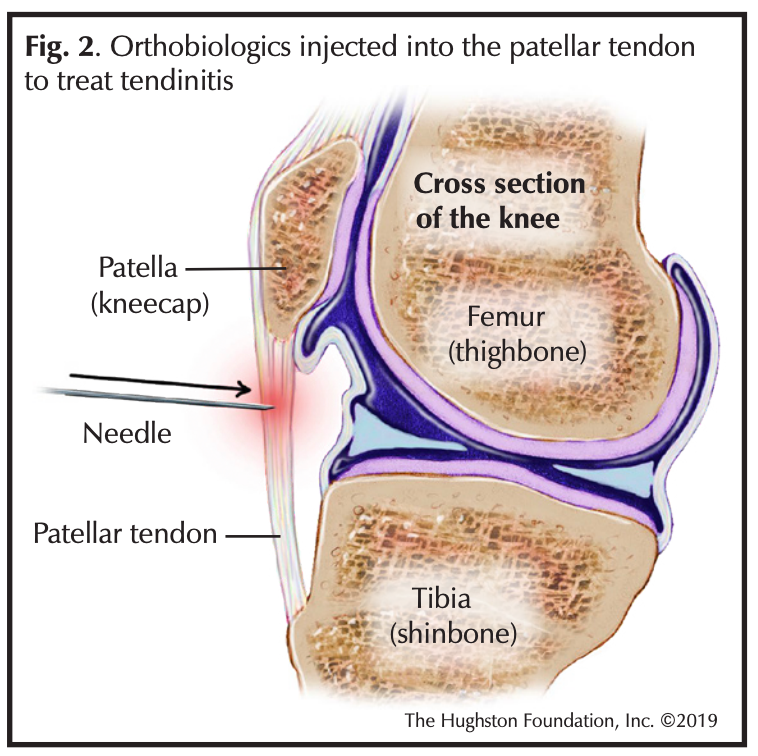
What are orthobiologics?
Orthobiologics are substances naturally found in the body that orthopaedists may use in higher concentrations to help speed up the repair/regeneration process. Natural substances can be bone marrow, blood, fat, or other soft tissues found in the body and they generally come from an autograft (your own tissue) or sometimes donor tissue. In particular, the latest research attention has been on using adipose (fat) tissue, scaffolds, stem cells, and blood component growth factors (Fig. 1) in both orthopaedic surgery and nonsurgical treatments.
To face the challenges of healing diseased or injured musculoskeletal tissues, your orthopaedist may employ orthobiologic therapy to build on the human body’s innate ability to repair and
heal itself. For years physicians have attempted to use diet, exercise, and anti-inflammatory medications, to modify the course and outcomes of illness, injuries, and degenerative conditions in a positive manner. If you want a minimally invasive procedure that allows you to avoid drugs, chemicals, or man-made materials, your physician may recommend orthobiologic therapy.
What does orthobiologic therapy treat?

Physicians and researchers have used orthobiologic therapy to treat a multitude of conditions, including golfer’s elbow, tennis elbow, Achilles tendinosis, rotator cuff tendinosis, plantar fasciitis, partia
l tendon and ligament tears (Fig. 2), osteoarthritis, muscle tears, and more. Whether your doctor uses orthobiologics as a simple nonsurgical option or part of a surgical procedure, you and your physician can decide what fits best with your lifestyle and current medical situation. Orthobiologics are not a first-line procedure, but rather, may be timely in the care continuum when other options have not been successful. Adding an orthobiologics procedure as a treatment option has given patients another choice when it comes to managing their orthopaedic condition. Ultimately, our goal is to get you back to living life and spending time doing the things that you love.
 How does your body heal itself?
How does your body heal itself?
The basis of orthobiologics is to build on the body’s inherent ability to repair/regenerate itself. When you are injured or have surgery, blood cells rush to the area. Blood and blood byproducts carry the necessary materials to initiate the cascade of events to start the reparative process.
Inflammation can be both good and bad for you. Each day you experience wear and tear damage to your body that is naturally controlled by inherent inflammatory processes. While excess inflammation can be detrimental, often in response to injury or damage, low-grade inflammation is triggered to start the cascade of cellular events to restore and repair damaged tissue. Therefore, physicians want to promote the low-grade inflammation that is part of the repair process.
What are the benefits of orthobiologics?
The procedures are minimally invasive, usually take under an hour, and can boost healing after a surgical procedure or physicians can use it as a stand-alone treatment to encourage soft tissue repair. Plus, your doctor can treat multiple joints at one time, such as injecting both knees to reduce pain and swelling. It is also ideal for patients who cannot undergo an extensive surgery due to other health conditions.
How are orthobiologic procedures performed?
Your orthopaedist can perform most of these procedures in the clinic, if they are administered through injections. Sometimes the therapies are done in conjunction with surgery, so the injection or treatment is provided during or right after your planned surgical procedure. Platelet rich plasma (PRP) injections may be performed in your doctor’s office. Your blood is drawn and then placed in a closed centrifuge system that then separates the blood components to create a concentrate of platelets (Fig. 1). Your doctor then injects this concentrate into the joint. These platelets adhere to the joint surfaces and release a number of growth factors to activate the body’s healing mechanisms.
For Lipogems®, the entire procedure often takes less than an hour and is performed in a hospital setting using local anesthesia (Fig. 3). During this procedure, the physician makes a tiny puncture through your skin to collect subcutaneous fat. Then this biologic material is placed in a sterile system that separates the cells to create a concentration of the wanted biologic substance. Next, the physician injects the resulting cells into the treatment site. These cells may positively influence the cellular chemistry at the site of injection to assist and augment the body’s healing processes.
Who will benefit from orthobiologics?
Orthobiologics can provide relief if you suffer from an injury or ailment that limits your normal daily functions or physical activity, especially if you have a soft tissue injury such as a partial tear in your tendon, ligament, or a muscle. If you had other treatments such as physical therapy, nonsteroidal anti-inflammatory medications (NSAIDS), or steroid injections that did not provide significant or long-lasting relief, orthobiologics may be a viable solution. You may want to try orthobiologics if you would like to explore a minimally invasive alternative to a major surgery. However, orthobiologics are not suitable for everyone. Your doctor will determine if a procedure will be beneficial to use in addition to your surgery or as a stand-alone treatment.
The treatment is helpful to many people participating in sporting activities. It may provide an alternative for athletes who do not want a more extensive surgery that requires a longer recovery. Furthermore, using orthobiologics during tissue repair surgery, such as a meniscus or labrum repair, may assist healing after surgery. Many patients suffering from orthopaedic pain are not ready for invasive surgery like a total joint replacement. They are also looking for longer lasting alternatives to cortisone injections and one that has fewer side effects. Patients can become frustrated with the duration of relief of other nonsurgical options, such as medications and physical therapy. This is why using your own tissue to help you heal is appealing, especially since one treatment is sometimes all that is needed.
Does the treatment have side effects?
The risk of side effects exists for most medical treatments and orthobiologics are no different. Rare, but possible, complications caused during the tissue harvest include an allergic reaction to the local anesthetic, damage to the underlying structures, infection, and hematoma or seroma (an accumulation of blood or fluid under the skin that may require removal).
How long do I have to wait to resume my daily activities?
Return to work and activity restrictions are dependent upon your treatment and the specific activities you do. Physicians often perform orthobiologic procedures using an injection, which allows the patient to return to work without much loss of time. Depending on the harvest and injection sites, your physician may restrict high-impact and strenuous activities for a couple of weeks. Most patients are able to return to their normal activities within one to two months. Typically, the recovery from the procedure is minimal when compared to a more invasive surgery.
Does insurance cover this treatment?
At present, your insurance may not cover the newer biologic treatments; however, patients weigh the benefits and often decide to self-pay for their procedure. You should keep in mind that the costs for orthobiologic procedures are often less than the co-pay for many surgical treatments and insurance does cover some specific orthobiologic procedures that have a longer track record.
Does this treatment always work?
There are no promises that an orthobiologic procedure will always work, but keep in mind that no medical treatment has full assurance. Orthobiologics are new and evolving, and researchers are studying the results, but only time from long term follow-up with patients can tell the true usefulness of the treatments. PRP is the most studied orthobiologic therapy because it has been around the longest. Long-term studies, by definition take time; therefore, it will be years before we know how effective these therapies are. Having a detailed discussion with your physician can help you to understand the process and the specifics as it applies to your problem.
A word of caution
You may have heard or read about cells regrowing or regenerating tissue; however, many of these experiments have been successful in the lab but not in the human body. There is still much to learn. While orthobiologics is an evolving field with many exciting potentials, the basic science must be merged with clinical outcomes. And as with all medical studies, clinical results take time; therefore be wary when you hear a lot of hype about breakthrough treatments that do not have clinical studies to back it up.
Author: Kurt E. Jacobson, MD, FACS | Columbus, Georgia
Last edited on July 27, 2022